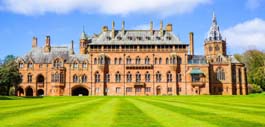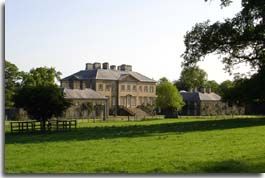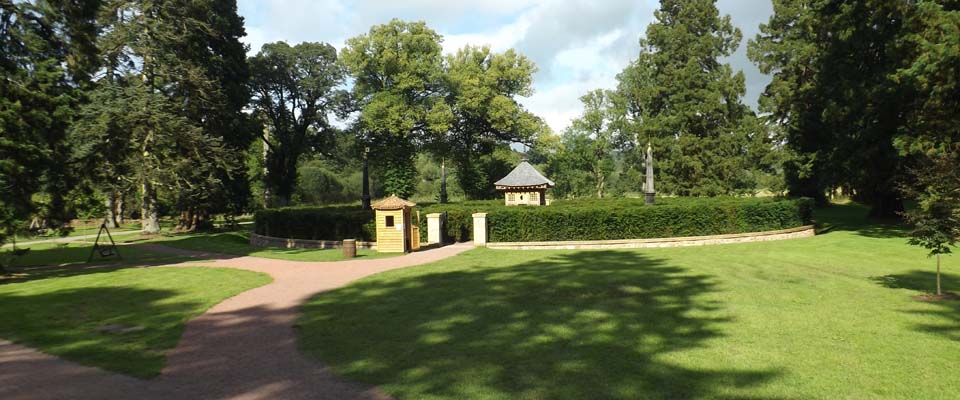History of Dumfries House.
This estate was originally named
Lochnorris or Lefnoreis, with the earliest
recorded owners being the Craufords
of Loudoun from the 1440s. The Craufords
main castle at that time was Loudoun Castle,
about 14 miles north by the town of Galston.
The Craufords main castle now is Crawfurdland Castle about 8 miles
northeast by Kilmarnock.
The Crauford Castle in this estate, named
Lefnoreis Castle, was about 100 yards west of
the present day Dumfries House, little
remains of that building above ground.
The estate passed from the Craufords in
1635 to William, 2nd Earl of Dumfries.
The present day Dumfries House was built
for William Dalrymple-Crichton, 5th Earl of
Dumfries (1699 – 1768).
The 5th Earl was a Scottish peer that
inherited the title of Earl of Dumfries in
1742, after the death of his mother Penelope
Crichton, 4th Countess of Dumfries.
The 5th Earl had served in the Army from
1721 to 1747. His retirement from the army
saw him settle in the estate and make plans
for a grand new house.
The 5th Earl contracted the Adam brothers
(Robert and John) to design a Palladian style
Mansion, with the building completed in
1758.
The interior furniture was designed
specially at that time for each area of the
house. The furniture was from the finest
craftsmen of the day, including Thomas
Chippendale. Most of that furniture still
sits where it was placed after the house was
completed.
The lands around the house were
re-designed at that time as well with a new
bridge over the river, and an avenue running
from the bridge to the house flanked by Giant
Redwood / Sequoia trees imported from America
in the 1800s.
|
The 7th Earl, born in 1793, was
the son of John, Lord Mount Stuart,
and Lady Elizabeth
McDouall-Crichton.
Lord Mount Stuart owned the
impressive Mount Stuart
mansion and estate on the Isle of
Bute, as seen right.
|
 |
The 7th Earl's father died when he was a
few months old. He was then raised by his
mother and grandmother at Dumfries House
until their deaths. He was then raised by his
grandfather at Mount Stuart.
The 7th Earl of Dumfries, also the 2nd
Marquess of Bute, was known as Lord Mount
Stuart. He accumulated vast wealth by
developing coal and iron industries. His most
profitable area was South Wales, where he was
credited with building Cardiff Docks.
Lord Mount Stuart owned Dumfries House,
Mount Stuart, Luton Hoo in Bedfordshire,
Cardiff Castle in South Wales, and had a
London town house on Campden Hill in
Kensington.
There was a number of coal and iron mines
around Dumfries House, it is unclear if the
Earls of Dumfries were involved in these
mines.
John Colum Crichton-Stuart, 7th Marquess
of Bute and 12th Earl of Dumfries, was born
in 1958. He is better known as Johnny
Dumfries, or John Bute, a British peer and
former F1 racing driver that won the 1988 24
Hours of Le Mans race.
The 12th Earl lives mainly in London, and
at times at Mount Stuart. His grandmother
lived at Dumfries House. The death of his
grandmother led to him putting Dumfries House
up for sale in 1994.
Talks with the National Trust For Scotland
fell through in 2007. Bute then stated he was
going to auction off the furniture, then sell
the house separately.
Word of the furniture to be auctioned at
Christies, created vast interest from around
the world, but especially in London.
This was the sale of the century, with the
media and wealthy seeking more
information.
I was approached by media companies for
images of Dumfries House at that time, as I
seemed to be the only person with high
resolution images of the building, taken just
a year or two before the furniture was to be
sold.
|
I had taken the images when
building up a section for my website
covering Ayrshire Mansions.
The image right, in higher
resolution, was the one used by the
media covering the story of the
Dumfries House auction.
|
 |
Once people saw the images of the
impressive house, and list of furniture to be
auctioned, many believed the house and
furniture should be kept together, to serve
as one of the top museums in the UK.
Prince Charles was one of these people,
helping form a consortium that bought the
house, its furniture and estate.
The house and furniture were restored and
opened to the public in the summer of
2008.
Ayrshire has a number of historic castles
and mansions, many that can be visited.
The area has fertile land with many
estates built up from the 1100s by families
that fought alongside Scottish Kings. Their
reward was large estates so they could rent
out most of the land to farmers, leading to a
wealthy life. Two of the most prominent of
these families were Wallace and Bruce, known
for their roles in the Scottish Wars of
Independence.
John Colum Crichton-Stuart, Johnny
Dumfries, John Bute, is said to be a
descendant of King Robert the Bruce. Bruce's
daughter married a Stuart in 1314, with their
son becoming the first of the Stuart kings,
Robert II.
Updates: John Colum
Crichton-Stuart, 7th Marquess of Bute,
died in 2021, his son born in 1989, John
Bryson Crichton-Stuart, is now the 8th
Marquess of Bute.
Prince Charles became King Charles after
the death of his mother Queen Elizabeth in
September 2022.
Related links: Ayrshire
Mansions .
Ayrshire Castles . Cumnock
Town
Ayr
Town . Dumfries House
Web
|
